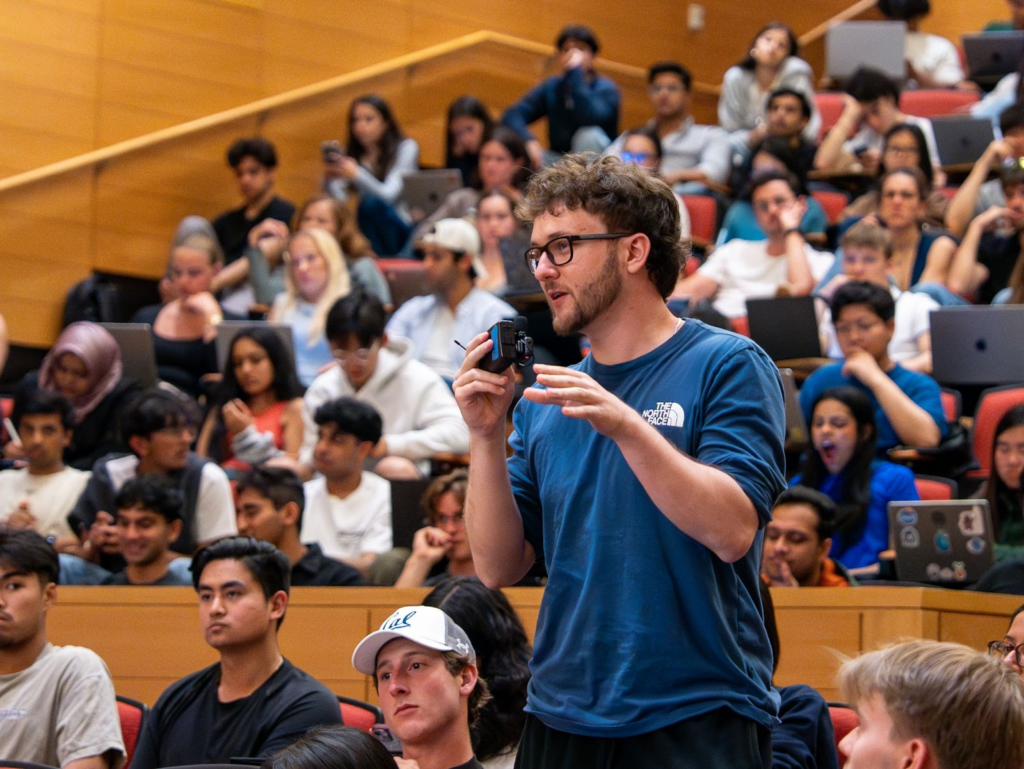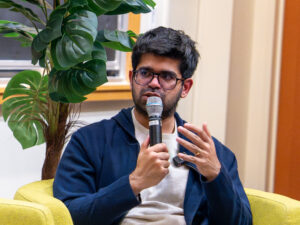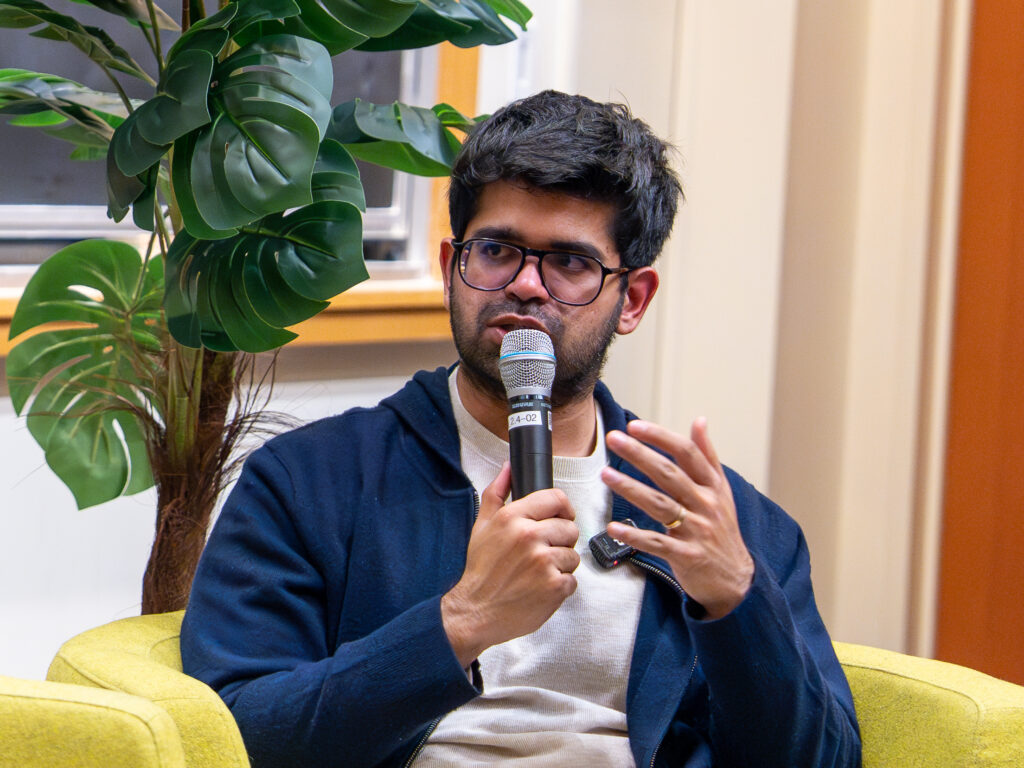Aravind Srinivas is the CEO and co-founder of Perplexity, a rapidly-growing startup redefining how we consume and synthesize information through AI. As a Berkeley PhD, surrounded by world-class labs and collaborators, he began shaping the vision that would become Perplexity: a smarter, more intuitive way to interact with information.
When Aravind first arrived at UC Berkeley, he was drawn by its academic excellence. Just across the bay, Stanford had long been known as the launchpad for tech giants like Google, Cisco, and Yahoo.
Yet Aravind didn’t want to only write great papers—he wanted to build something. He often found himself turning to his lab mate Peter Chen, “Hey, do you want to start a company with me?”
Today, that energy has shifted. What Stanford was to the dot-com boom, Berkeley has become in the age of AI. Many of the most exciting AI startups are now emerging from Berkeley’s labs.
Why the shift?
“In AI, things move quickly from research to practice,” Aravind explains. “Being at the very frontier of research puts you in the best position to build some of the frontier.”
Research and application are rapidly converging. The tools and theories developed in academic labs and papers are increasingly becoming the foundation for practical, real-world systems and technologies.
As Berkeley became a global hub for AI innovation, students and researchers came not only to publish, but also to prototype, collaborate, and create. “It was clearly the most exciting thing that could be happening. Everybody just wanted to come here.”
While building Perplexity in such an environment, Aravind reflects on what defines a successful entrepreneur during his guest appearance in the Richard Newton Lecture Series. This interview was conducted by Pieter Abbeel, Aravind’s former PhD advisor and one of the world’s leading researchers in AI and reinforcement learning, known for his work of changing paradigms in robotics. Pieter is also the co-founder of Covariant.ai, a leading AI robotics startup bringing advanced machine learning to warehouse operations, enabling intelligent robots to perform complex tasks with human-level autonomy. Driven by a fascination with how neural networks can lead to practical breakthroughs across disciplines, Pieter’s work bridges deep learning, control systems, and machine learning.
Their conversation—part mentorship, part reflection—offers insight into both the academic roots and practical thinking behind Perplexity. Pieter’s questions draw out both Aravind’s journey, as well as the values and decisions shaping the rapidly evolving frontier of AI. Here are a few key takeaways from Aravind’s experience in navigating how research work can translate to venture building.
Build Where Others Aren’t Looking (Especially If It’s Boring)
Perplexity CEO & Founder Aravind Srinivas
with his former PhD advisor, Pieter Abbeel
At a time when most founders were chasing social apps or crypto hype, Aravind leaned into a space many assumed was already solved: information consumption. Google had dominated for decades. Why bother?
Aravind realized that the AI research happening at Berkeley could fundamentally change not only how people access knowledge, but understand and synthesize it. If AI could summarize, contextualize, and explain — why should knowledge consumption just be a list of links?
Aravind started with a simple question: What if accessing information felt like talking to a personal research assistant?
That question became Perplexity.
Whether analyzing research questions or building products, it’s a reminder that even “solved” problems deserve reinvestigation.
Takeaway:
✍️“Boring” problems are often where the biggest opportunities lie. Look for problems that others seem to ignore or accept. The most overlooked ideas are often most ready for reinvention.
Teaching “Generative AI” before it was “Generative AI”
In 2020, before “generative AI” became a buzzword, Aravind co-created a Berkeley course called CS294: Deep Unsupervised Learning.
Together, Pieter Abbeel and Aravind Aravind Srinivas, along with Peter Chen, and Jonathan Ho taught the field before people even realized it was an exciting space. While they weren’t fully fluent in it, they recognized its potential. They decided to teach it. In the process, they forced themselves to master it.
“If you cannot explain it to people who don’t know anything about it, then you don’t understand it.”
Takeaway:
✍️ Don’t wait until you’re an expert. Teaching, writing, or speaking about what you’re learning helps you learn faster, attract collaborators, and build credibility.
Simple Ideas Scale.

During his OpenAI internship, Aravind pitched a set of what he thought were brilliant ideas to a mentor. Aravind waited for his mentor to tell him they were cool.
His mentor wasn’t impressed.
Why? They were too complicated.
His mentor took out a whiteboard and drew two circles: a large circle titled “unsupervised generative learning,” and a smaller circle inside it titled “reinforcement learning.”
Together, these circles formed the conceptual foundation for artificial generative intelligence (AGI), and ultimately GPT and Perplexity.
Takeaway:
✍️How simply can you explain your idea? To build a startup, simplify.
The Founder Superpower
“The most successful professionals are those who are able to communicate and articulate their thoughts well.”
Aravind isn’t just a builder, he’s a communicator. In fact, he was one of the first to popularize the now-standard Twitter threads summarizing research papers.
Rather than just posting a PDF or a link to the paper, he’d break it down in a thread, breaking down the important pieces, to make complex ideas digestible to a broader audience. Make it easy for people to read.
Ideas don’t matter unless people understand them.
“Clarity of thought is the most important thing—even when you’re talking to an AI—to get something done.” Founders need to be “eloquent, precise, and communicate what they actually want.”
Even as a CEO, Aravind doesn’t delegate marketing. He argues that those who have built the product are in the best position to explain why it matters.
Aravind recommends that all students master communication.
This also includes students pursuing research. The best people to explain breakthrough ideas are often the ones who discovered them.
Takeaway:
✍️ Learn to sell your vision—to users, investors, academics, and the world. Your ability to communicate will make or break your startup.
Never Outsource Your Curiosity
When the team was working on a browser, Aravind realized he did not have a strong background in operating systems, browsers, or web development. However, as a founder, he knew that to lead effectively, he couldn’t rely solely on others. He needed to understand the details himself to guide the team.
Aravind turned to Perplexity.
“What is a user agent?”
“How does it send requests to the server?”
What are the different rendering engines used for different browsers?”
He asked hundreds of questions, inside his own product.
Takeaway:
✍️ Whether you’re leading a team or pushing the frontier of science, relentless curiosity and rapid learning are essential.
Embrace Failure. It’ll Guide You.
Aravind originally aimed to study computer science but missed the cutoff for the JEE, India’s entrance exam. He ended up in electrical engineering instead. When he had the opportunity to switch, he narrowly missed again.
While disappointed at first, Aravind soon realized that electrical engineering gave him something arguably more valuable: a deep understanding of systems, signals, circuits, and computations.
An electrical engineering degree provides a deep foundation of how computers really work, translating to a better understanding of how scientific computing works in Python, which a computer science degree lacked.
That depth proved critical for AI research and product development.
Takeaway:
✍️ What feels like failure now might be setting you up for future unexpected advantages. Reframe rejection as redirection.
Conclusion
To every student, researcher, and aspiring entrepreneur: Aravind’s journey shows that you don’t need to have all the answers to begin—you just need the mindset to keep learning.
Whether you’re typing notes at a lecture hall, experimenting in a lab, or sketching ideas on a napkin at a coffee shop, building starts with curiosity, clarity of thought, and the courage to venture where others don’t.
Don’t wait to feel ready. Don’t wait for permission. If you see a problem worth solving, start building. The path won’t be straight, and failure is inevitable. Still, each step will teach you something that brings you closer to something meaningful.
Pieter’s conversation with Aravind surfaces questions worth considering for any individual wanting to make change: How does theory translate into practical innovation? How is the publication-to-product pipeline changing in AI? What does technical leadership look like at scale?
Whether you’re crafting papers or products, the principles remain the same: Identify overlooked ideas. Stay curious. Learn to communicate well. And keep pushing forward, especially when the path isn’t clear.
Aravind Srinivas is the CEO and co-founder of Perplexity, a rapidly-growing startup redefining how we consume and synthesize information through AI. As a Berkeley PhD, surrounded by world-class labs and collaborators, he began shaping the vision that would become Perplexity: a smarter, more intuitive way to interact with information.
When Aravind first arrived at UC Berkeley, he was drawn by its academic excellence. Just across the bay, Stanford had long been known as the launchpad for tech giants like Google, Cisco, and Yahoo.
Yet Aravind didn’t want to only write great papers—he wanted to build something. He often found himself turning to his lab mate Peter Chen, “Hey, do you want to start a company with me?”
Today, that energy has shifted. What Stanford was to the dot-com boom, Berkeley has become in the age of AI. Many of the most exciting AI startups are now emerging from Berkeley’s labs.
Why the shift?
“In AI, things move quickly from research to practice,” Aravind explains. “Being at the very frontier of research puts you in the best position to build some of the frontier.”
Research and application are rapidly converging. The tools and theories developed in academic labs and papers are increasingly becoming the foundation for practical, real-world systems and technologies.
As Berkeley became a global hub for AI innovation, students and researchers came not only to publish, but also to prototype, collaborate, and create. “It was clearly the most exciting thing that could be happening. Everybody just wanted to come here.”
While building Perplexity in such an environment, Aravind reflects on what defines a successful entrepreneur during his guest appearance in the Richard Newton Lecture Series. This interview was conducted by Pieter Abbeel, Aravind’s former PhD advisor and one of the world’s leading researchers in AI and reinforcement learning, known for his work of changing paradigms in robotics. Pieter is also the co-founder of Covariant.ai, a leading AI robotics startup bringing advanced machine learning to warehouse operations, enabling intelligent robots to perform complex tasks with human-level autonomy. Driven by a fascination with how neural networks can lead to practical breakthroughs across disciplines, Pieter’s work bridges deep learning, control systems, and machine learning.
Their conversation—part mentorship, part reflection—offers insight into both the academic roots and practical thinking behind Perplexity. Pieter’s questions draw out both Aravind’s journey, as well as the values and decisions shaping the rapidly evolving frontier of AI. Here are a few key takeaways from Aravind’s experience in navigating how research work can translate to venture building.
Build Where Others Aren’t Looking (Especially If It’s Boring)
Perplexity CEO & Founder Aravind Srinivas
with his former PhD advisor, Pieter Abbeel
At a time when most founders were chasing social apps or crypto hype, Aravind leaned into a space many assumed was already solved: information consumption. Google had dominated for decades. Why bother?
Aravind realized that the AI research happening at Berkeley could fundamentally change not only how people access knowledge, but understand and synthesize it. If AI could summarize, contextualize, and explain — why should knowledge consumption just be a list of links?
Aravind started with a simple question: What if accessing information felt like talking to a personal research assistant?
That question became Perplexity.
Whether analyzing research questions or building products, it’s a reminder that even “solved” problems deserve reinvestigation.
Takeaway:
✍️“Boring” problems are often where the biggest opportunities lie. Look for problems that others seem to ignore or accept. The most overlooked ideas are often most ready for reinvention.
Teaching “Generative AI” before it was “Generative AI”
In 2020, before “generative AI” became a buzzword, Aravind co-created a Berkeley course called CS294: Deep Unsupervised Learning.
Together, Pieter Abbeel and Aravind Aravind Srinivas, along with Peter Chen, and Jonathan Ho taught the field before people even realized it was an exciting space. While they weren’t fully fluent in it, they recognized its potential. They decided to teach it. In the process, they forced themselves to master it.
“If you cannot explain it to people who don’t know anything about it, then you don’t understand it.”
Takeaway:
✍️ Don’t wait until you’re an expert. Teaching, writing, or speaking about what you’re learning helps you learn faster, attract collaborators, and build credibility.
Simple Ideas Scale.

During his OpenAI internship, Aravind pitched a set of what he thought were brilliant ideas to a mentor. Aravind waited for his mentor to tell him they were cool.
His mentor wasn’t impressed.
Why? They were too complicated.
His mentor took out a whiteboard and drew two circles: a large circle titled “unsupervised generative learning,” and a smaller circle inside it titled “reinforcement learning.”
Together, these circles formed the conceptual foundation for artificial generative intelligence (AGI), and ultimately GPT and Perplexity.
Takeaway:
✍️How simply can you explain your idea? To build a startup, simplify.
The Founder Superpower
“The most successful professionals are those who are able to communicate and articulate their thoughts well.”
Aravind isn’t just a builder, he’s a communicator. In fact, he was one of the first to popularize the now-standard Twitter threads summarizing research papers.
Rather than just posting a PDF or a link to the paper, he’d break it down in a thread, breaking down the important pieces, to make complex ideas digestible to a broader audience. Make it easy for people to read.
Ideas don’t matter unless people understand them.
“Clarity of thought is the most important thing—even when you’re talking to an AI—to get something done.” Founders need to be “eloquent, precise, and communicate what they actually want.”
Even as a CEO, Aravind doesn’t delegate marketing. He argues that those who have built the product are in the best position to explain why it matters.
Aravind recommends that all students master communication.
This also includes students pursuing research. The best people to explain breakthrough ideas are often the ones who discovered them.
Takeaway:
✍️ Learn to sell your vision—to users, investors, academics, and the world. Your ability to communicate will make or break your startup.
Never Outsource Your Curiosity
When the team was working on a browser, Aravind realized he did not have a strong background in operating systems, browsers, or web development. However, as a founder, he knew that to lead effectively, he couldn’t rely solely on others. He needed to understand the details himself to guide the team.
Aravind turned to Perplexity.
“What is a user agent?”
“How does it send requests to the server?”
What are the different rendering engines used for different browsers?”
He asked hundreds of questions, inside his own product.
Takeaway:
✍️ Whether you’re leading a team or pushing the frontier of science, relentless curiosity and rapid learning are essential.
Embrace Failure. It’ll Guide You.
Aravind originally aimed to study computer science but missed the cutoff for the JEE, India’s entrance exam. He ended up in electrical engineering instead. When he had the opportunity to switch, he narrowly missed again.
While disappointed at first, Aravind soon realized that electrical engineering gave him something arguably more valuable: a deep understanding of systems, signals, circuits, and computations.
An electrical engineering degree provides a deep foundation of how computers really work, translating to a better understanding of how scientific computing works in Python, which a computer science degree lacked.
That depth proved critical for AI research and product development.
Takeaway:
✍️ What feels like failure now might be setting you up for future unexpected advantages. Reframe rejection as redirection.
Conclusion
To every student, researcher, and aspiring entrepreneur: Aravind’s journey shows that you don’t need to have all the answers to begin—you just need the mindset to keep learning.
Whether you’re typing notes at a lecture hall, experimenting in a lab, or sketching ideas on a napkin at a coffee shop, building starts with curiosity, clarity of thought, and the courage to venture where others don’t.
Don’t wait to feel ready. Don’t wait for permission. If you see a problem worth solving, start building. The path won’t be straight, and failure is inevitable. Still, each step will teach you something that brings you closer to something meaningful.
Pieter’s conversation with Aravind surfaces questions worth considering for any individual wanting to make change: How does theory translate into practical innovation? How is the publication-to-product pipeline changing in AI? What does technical leadership look like at scale?
Whether you’re crafting papers or products, the principles remain the same: Identify overlooked ideas. Stay curious. Learn to communicate well. And keep pushing forward, especially when the path isn’t clear.


